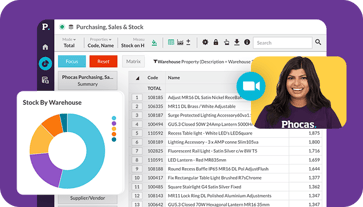How to improve supplier relationship management
Manufacturers, distributors and retailers rely heavily on their suppliers to deliver quality products on time and at the right price. Strong supplier relationship management (SRM) is essential for these industries because it enables you and your suppliers to map out the supply chain, achieve economies of scale and offer customers an extensive choice of products.
We investigate some practical strategies to improve your supplier relationships and strategic sourcing.
What is supplier relationship management?
Supplier relationship management (SRM) is the systematic approach to evaluating, managing and improving interactions with the suppliers that provide goods and services to your business. It goes beyond procurement and price negotiation, focusing instead on building partnerships that create shared value.
SRM combines sourcing, supplier segmentation and performance management. It equips procurement teams and stakeholders with the supplier data, KPIs and communication channels they need to align suppliers with business goals. Effective supplier relationship management ensures transparency, streamlines workflows and builds trust that leads to stronger supplier relationships.
Benefits of effective supplier relationship management
Some of the biggest advantages of SRM include cost savings and efficiency. By leveraging supplier data and performance metrics, organizations can streamline procurement processes, optimize lead times and achieve cost efficiency. Negotiating favorable payment terms can also improve cash flow, helping businesses reinvest in growth. When providers and procurement teams share consolidated data, they can adapt quickly to supply chain disruptions. This responsiveness allows businesses to maintain consistent product supply and meet customer expectations.
Supplier risk has been a major concern since covid and the ongoing disruption of travel routes. SRM helps organizations create contingency plans, monitor supplier performance and identify vulnerabilities in the supply chain. This proactive approach reduces the impact of disruptions and ensures continuity.
Strong supplier relationships are built on regular communication and open dialogue. When suppliers see transparency and fair performance management, they are more likely to become strategic suppliers who prioritize your needs.
A well-managed supply chain means fewer delays, higher product quality and a better overall experience for your customers. This is a win-win for both you and your suppliers.

“Our favourite metric to track with Phocas is OTIF – on time in full,” says Melanie Baker, Director of Supply Chain at PSS Industrial Group.
PSS Industrial Group (PSSI) is a leading products distributor and manufacturer of specialty equipment for all sections of the oil and gas energy market.
The vendor and supplier partnerships are extremely important to the business as the products they supply help to attract and keep their customers. Having access to over 700,000 stock-keeping units (SKUs) from thousands of vendors makes PSS Industrial a valuable part of customer’s supply chains.
To keep the relationships strong and transparent, PSSI shares analysis of the supply chain with suppliers in Phocas. The information helps to improve category performance and reduce waste.
“I sit down with a supplier partner and show them in black and white how they are performing. We look at Phocas dashboards and KPIs,” says Melanie.
Rather than running a report and sending it to them, we look at real-time results live on screens in the office.
“Our suppliers are just as impressed as me at how nimble and easy it is to get the data from Infor with Phocas,” adds Melanie.
The role of supplier performance management data and analysis
A central feature of effective supplier relationship management is performance management or measurement. Organizations must measure supplier performance using key performance indicators (KPIs) such as:
-
Delivery on time and in full (DIFOT) – lead times, consistency
-
Product quality – returns, defects, compliance with quality standards
-
Price competitiveness – relative to market averages
-
Sales performance – how well products perform with customers
-
Contract adherence – payment terms, service levels, workflows
Access to this supplier data not only helps procurement teams with decision-making, but it also builds transparency into the business relationship. Suppliers can see how they’re being evaluated and use those insights for continuous improvement.
New ways to improve supplier relationship management
Improving your SRM strategy requires cultural and operational changes. Here are some most effective strategies to use alongside implementing analytics and rebate software.
Clear communication
Open communication is critical to building trust. Regular communication with key suppliers ensures alignment on business goals, expectations and quality. Use dashboards for purchase orders, performance updates and forecasting.
Measure KPIs
Develop clear metrics that measure supplier performance. Share these KPIs openly with your suppliers so they can track their progress. Dashboards also make it easier to spot disruptions early and suggest a new plan.
Segment you suppliers like you do for customers
Identify your key suppliers and dedicate resources to strengthening those partnerships. Supplier segmentation ensures that procurement teams focus on the relationships that matter most to the bottom line and your rbate program.
Prepare contingency plans
Supply chain disruptions are inevitable. Effective SRM requires proactive risk management and contingency plans to ensure supply continuity when problems arise.
Promote ongoing improvement
Encourage suppliers to participate in initiatives that enhance cost efficiency and service delivery. Performance reviews and joint planning sessions can drive continuous improvement and innovation.
Effective supplier relationship management drives business success. Companies like PSS Industrial demonstrate how leveraging supplier data and focusing on open communication can transform procurement functions and deliver competitive advantage. By monitoring metrics and aligning business goals with key suppliers, manufacturers and distributors can achieve cost efficiency and risk mitigation within supply chain management.
When supply chain disruptions are the norm, strong supplier relationships are a great defence and an even greater opportunity.


Katrina is a professional writer with a decade of experience in business and tech. She explains how data can work for business people and finance teams without all the tech jargon.
Related blog posts

DIFOT (Delivered In-Full, On-Time) or OTIF (On-Time In-Full) is a fundamental KPI when analyzing the performance of your supply chain. The main goal is to get your customers the products they need, when they need them, in the quantity they ordered. DIFOT measures how successful your business is at achieving this objective and identifies procurement problems and supplier reliability.
Read more
The U.S. wholesale distribution sector is experiencing a rapid acceleration in mergers & acquisitions (M&A) activity. From HVAC buying groups like Johnstone Supply acquiring independents, to family-owned distributors selling due to succession challenges, consolidation is reshaping the distribution landscape. One recent example is Hein Electric Supply's acquisition of Laser Electric Supply highlights how strategic buyers are capitalizing on opportunities across the middle market.
Read more
The Spring 2025 Fortune/Deloitte CEO Survey presents a consistent story of boardrooms experiencing a sense of cautious optimism controlled by an emphasis on fiscal responsibility. This is playing out with 42% of CEOs saying they want their teams to focus on cost-cutting measures without raising prices to avoid losing their customers.
Read moreBrowse by category

Find out how our platform gives you the visibility you need to get more done.
Get your demo today